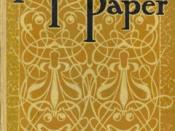Charlotte Perkins Gillman wrote "The Yellow Wallpaper" in 1892. Throughout this grim tale, she presents undertones of inequalities and the oppression of women in the 19th century. Similar to the unknown writer, Gilman underwent a type of rest treatment after suffering from bouts of severe depression following the birth of her daughter. The well-known physician S. Weir Mitchell popularized this type of treatment. The story is the tale of a woman who goes mad after being prescribed a "rest cure" to relieve her of her desire to write. Coincidently, this is after the birth of her child as well. "The Yellow Wallpaper" actually chronicles the process of going insane. According to Shawn St. Jean, this piece of literature was an influential piece in the extensive enlightening feminist movement that fostered the return of women's voices in society. (Feminist studies) Moreover, Gillman presents how archaic the medical field was towards women's mental health.
Gillman illustrates how women were placed in a subservient role to their male figures in family and society as a whole. The story is very Ironic in the terms of the author herself because Gillman was prescribed a similar treatment by a prominent doctor in her area named Weir Mitchell. Dr. Mitchell believed in the afore mentioned "rest cure" were the sick patient predominantly women were forced to rest to cure the nervous prostration they were diagnosed with. Gillman, suffered from a form of neurasthenia. Furthermore, the actual treatment itself leaves the anonymous protagonist in the story in worse mental shape than ever.
The story begins with the anonymous author and her physician husband John, renting a colonial mansion. Gilman's meticulous narrative of the house begins outside of it. "The most beautiful place! It is quite alone, standing well back from the road, quite...


